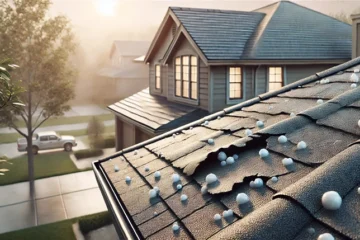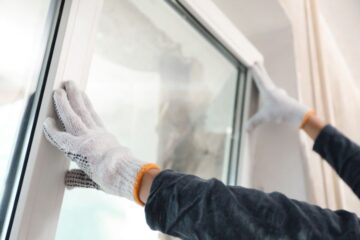Best Methods for Restoring Old Outdoor Wicker Furniture

If you’ve ever owned outdoor wicker furniture, you know how beautiful and charming it can be, especially in garden spaces or on patios. However, over time, exposure to the elements can take a toll on its appearance and durability. In this guide, we’ll explore the best methods for restoring old outdoor wicker furniture, so it can regain its original beauty and extend its lifespan.
Restoring old wicker furniture doesn’t have to be complicated, and with a little effort, you can breathe new life into it. Let’s look at how you can do this step by step.
Why Does Wicker Furniture Deteriorate Over Time?
Wicker furniture is often made from natural materials such as rattan, bamboo, or reed, and these materials are vulnerable to environmental factors like moisture, heat, and sunlight. Over time, this can lead to fading, brittleness, and even structural damage. If your wicker furniture is left outside for long periods without protection, the combination of rain, UV rays, and fluctuating temperatures can cause it to degrade more quickly.
How Do Weather Conditions Affect Wicker?
Understanding how different weather conditions affect your wicker furniture is crucial in preventing further damage and preparing for restoration:
- Moisture: Wicker is porous, which means it absorbs water. Rain or even morning dew can cause it to warp or develop mold and mildew.
- Sunlight: Prolonged exposure to sunlight can lead to the drying out of wicker materials, making them brittle and prone to cracking.
- Temperature Fluctuations: Extreme temperature changes cause natural materials to expand and contract, which weakens the wicker over time.
Assessing the Condition of Your Old Wicker Furniture
Before diving into restoration, you need to evaluate the extent of the damage to your wicker furniture. Some wicker pieces might only need a fresh coat of paint, while others could require more extensive repairs. Here’s how you can assess the condition:
- Check for loose or broken weaves. These can often be repaired, but you need to identify them first.
- Look for mold, mildew, or rot. Moldy wicker is often a result of prolonged moisture exposure and can sometimes be cleaned, but rot might require replacement of sections.
- Examine the frame underneath the wicker. If the frame is rusted or damaged, it may affect the stability of the entire piece.
How to Clean Old Wicker Furniture
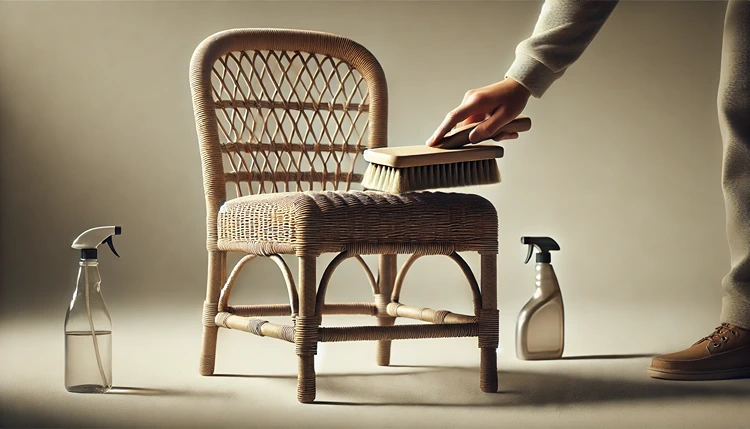
Cleaning is an essential step in restoring old wicker furniture. Dirt, grime, and mold can accumulate in the crevices of the weave, and you’ll need to remove these before you can move on to painting or repairing. Here’s how you can clean your wicker furniture thoroughly:
Step-by-Step Cleaning Process
- Dusting: Start by dusting off loose dirt with a soft brush or a vacuum cleaner with a brush attachment. Be gentle to avoid damaging any brittle parts.
- Washing: Mix a solution of warm water and mild dish soap. Use a sponge or soft cloth to gently scrub the wicker. For hard-to-reach areas, a soft toothbrush can be helpful.
- Rinsing: Rinse off the soap with clean water, but avoid soaking the furniture. Too much water can cause further damage.
- Drying: Let the furniture dry thoroughly in a shaded area. Do not place it in direct sunlight, as this could cause the wicker to dry out and crack.
Helpful Hint:
To clean mold or mildew, use a mixture of equal parts water and white vinegar. Apply it with a sponge, let it sit for 10-15 minutes, then scrub gently with a soft brush. Be sure to rinse and dry the furniture well to prevent further mildew growth.
Repairing Wicker Furniture: What You Need to Know
Once your wicker furniture is clean, the next step is to repair any broken or loose parts. Wicker repair can be tricky, but with patience and the right tools, you can do it yourself. Here are the main areas you might need to focus on:
How to Repair Loose Weave
If you notice sections where the weave is coming undone, you can usually repair these by re-wrapping the wicker strands. Follow these steps to fix the loose weave:
- Soak the wicker: Soak the loose strands in warm water for 10-15 minutes to make them more pliable.
- Re-wrap: Gently weave the softened strands back into place. Be careful not to force them, as they can break if they’re too brittle.
- Secure: Use a dab of wood glue to secure the ends of the strands.
For larger areas where multiple weaves have come undone, you may need to replace sections of wicker. Most craft stores sell replacement wicker, or you can source it online. Measure the existing wicker to ensure you buy the right size and color.
Fixing Cracks in Wicker
If parts of the wicker have cracked or broken, but the structure is still intact, you can use wood glue to bond the pieces back together. Make sure the area is clean and dry before applying the glue. Hold the cracked pieces together for several minutes until the glue sets.
Helpful Hint:
If your wicker furniture has extensive damage, consider contacting a professional wicker repair service. They can expertly replace damaged sections and refinish your furniture to look like new.
Should You Repaint or Re-Stain Wicker Furniture?
After cleaning and repairing your wicker furniture, you’ll likely want to refresh its appearance with a new coat of paint or stain. But which option is better? Here’s what you need to know:
Painting vs. Staining Wicker: Which Is Best?
The decision between painting or staining depends on the look you want to achieve and the condition of the furniture:
- Paint: Paint provides a solid color and helps protect the wicker from future damage. It’s great for covering up imperfections and giving your furniture a fresh look.
- Stain: Staining allows the natural texture of the wicker to show through, which can be appealing if you like the look of the natural fibers. However, stain doesn’t offer as much protection as paint, so you might need to reapply it more frequently.
If you decide to paint your wicker furniture, make sure to use a high-quality exterior-grade paint. Spray paint is often the best option for an even finish and easier application, especially for hard-to-reach areas in the weave.
How to Paint Wicker Furniture for a Long-Lasting Finish
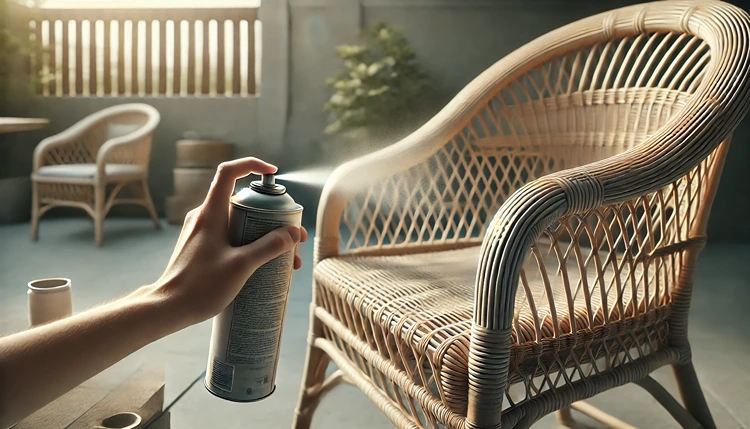
If you’ve decided to paint your wicker furniture, doing it the right way is key to ensuring a long-lasting, beautiful finish. Painting wicker can be tricky because of all the small crevices, but with the right technique, you can get great results. Here’s a step-by-step guide to help you through the process.
Steps for Painting Wicker Furniture
- Prepare the Surface: Before painting, ensure your wicker is clean and dry. Any dust, grime, or old paint will affect the paint’s ability to adhere. Use a wire brush to remove old, flaky paint if necessary.
- Sand the Wicker: Lightly sand the wicker with fine-grit sandpaper to create a surface that the paint can grip. Be careful not to damage the delicate weave.
- Choose the Right Paint: For outdoor wicker furniture, it’s best to use a high-quality, weather-resistant spray paint. Spray paint offers better coverage for intricate surfaces like wicker.
- Apply Primer: Use an oil-based spray primer that’s designed for outdoor use. Apply a thin, even coat and allow it to dry completely before moving to the next step.
- Spray Paint in Layers: Hold the spray can about 8-10 inches from the surface and apply light, even coats of paint. Don’t try to cover everything in one coat—multiple light coats will give a better, longer-lasting finish. Let each coat dry before applying the next one.
- Finish with a Sealant: Once the paint is dry, apply a clear, weather-resistant sealant to protect your furniture from moisture and UV damage. This is especially important if your wicker will be exposed to the elements.
Helpful Hint:
If you’re painting wicker furniture that will be exposed to heavy rain or intense sun, consider using marine-grade paint. It’s designed to withstand harsh conditions, making it a great choice for outdoor furniture.
Essential Tools and Materials for Restoring Wicker Furniture
| Tool/Material | Purpose |
|---|---|
| Soft Brush | Dusting off loose dirt and debris before cleaning |
| Vacuum Cleaner with Brush Attachment | Removing dirt from hard-to-reach areas in the wicker weave |
| Warm Water and Mild Dish Soap | Cleaning the wicker thoroughly without damaging the fibers |
| Wood Glue | Repairing cracks or loose strands in the wicker |
| Oil-Based Primer | Prepping the surface for paint and preventing moisture damage |
| Spray Paint | Evenly coating the wicker with weather-resistant paint |
| Clear Sealant | Protecting the finished furniture from UV rays and moisture |
Staining Wicker: When and How to Do It
If you prefer to retain the natural beauty of your wicker, staining is a great option. Stain highlights the wicker’s texture and grain, but it requires more maintenance than paint. Here’s how to stain your wicker furniture effectively:
Steps for Staining Wicker Furniture
- Clean the Surface: Like with painting, your furniture should be completely clean and dry before you start. Dirt or moisture will affect how the stain penetrates the wicker.
- Choose the Right Stain: For outdoor furniture, use an oil-based stain that’s designed for exterior use. These stains offer more protection from moisture and UV rays.
- Apply the Stain: Using a brush, apply the stain evenly, working it into the weave. You may need to use a smaller brush for tight areas. Allow the first coat to soak in and dry completely before applying a second coat if needed.
- Seal the Wicker: Once the stain has dried, apply a clear protective sealer. This will protect the wicker from the elements and prolong the life of the stain.
Staining wicker gives a more natural look compared to paint, but you’ll need to reapply the stain every couple of years to maintain the furniture’s appearance and protect it from wear.
How to Protect Outdoor Wicker Furniture After Restoration
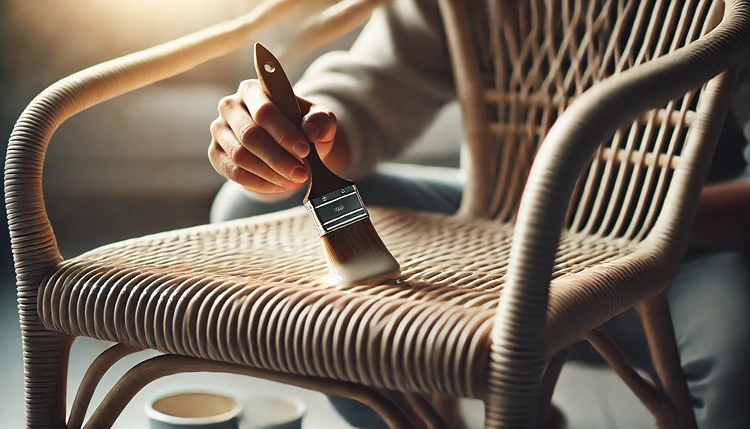
Once your wicker furniture is clean, repaired, and freshly painted or stained, it’s essential to take steps to protect it from future damage. With proper care, your restored wicker can last for many more years. Here are some tips to keep your furniture in good condition:
How to Protect Wicker from Weather Damage
- Use Furniture Covers: Invest in high-quality outdoor furniture covers to protect your wicker from rain, sun, and snow. This will prevent moisture from seeping into the material and stop the sun from causing fading and brittleness.
- Store Furniture During Off-Season: If possible, bring your wicker furniture inside during the winter months or when you’re not using it for an extended period. Even in covered areas, the elements can still reach outdoor furniture and cause damage.
- Apply a Sealant Annually: Reapply a weather-resistant sealant each year to protect the wicker. This is especially important if your furniture is exposed to moisture and sunlight regularly.
- Keep it Clean: Regularly dust and clean your wicker furniture to prevent dirt buildup, which can lead to mildew and mold in humid climates.
Helpful Hint:
Consider moving your wicker furniture to a covered area during rainy seasons. While outdoor wicker is designed to withstand the elements, prolonged exposure to water can accelerate its deterioration.
Signs It Might Be Time to Replace Wicker Furniture
Despite your best efforts at restoration, there may come a time when wicker furniture has reached the end of its useful life. Here are some signs that it might be time to replace rather than restore:
- Severe Cracking or Splitting: If large sections of the wicker are cracked or split beyond repair, it may be too damaged to restore.
- Rotted Frame: If the frame of your wicker furniture has rusted or rotted, the structural integrity may be compromised, making it unsafe to use.
- Mold or Mildew Damage: While mold and mildew can often be cleaned, if they’ve penetrated deep into the wicker fibers, it may be impossible to remove them entirely.
In these cases, it might be best to retire your old furniture and invest in a new set. However, if you’ve managed to keep the frame intact and the damage is minimal, restoring wicker furniture is a great way to keep enjoying it for years to come.
Stats:
A survey by the American Home Furnishings Alliance revealed that 60% of homeowners prefer restoring outdoor furniture over replacing it. The primary reasons cited were cost savings and sentimental value.
Advantages and Drawbacks of Restoring Old Wicker Furniture
Pros
- Cost-effective compared to purchasing new furniture.
- Allows you to maintain sentimental or vintage pieces.
- Customizable – you can repaint or restain in your preferred colors.
- Eco-friendly option by reducing waste and the need for new materials.
- Relatively simple DIY project that can be done at home.
Cons
- Restoring wicker can be time-consuming.
- Some repairs, like replacing broken weaves, may be tricky.
- Not all damage can be fully repaired, especially with extensive weather exposure.
- Requires regular maintenance to prolong the life of the restored furniture.
- Outdoor exposure means you may need to repaint or reseal frequently.
FAQs
Wrapping Up
Restoring old outdoor wicker furniture is a cost-effective, eco-friendly solution to breathe new life into your favorite patio pieces. Whether you’re painting, staining, or simply repairing, these methods allow you to retain the charm of wicker furniture while extending its lifespan. By following the best practices for cleaning, repairing, and protecting, you can ensure your restored wicker furniture stays beautiful and functional for years to come. Regular maintenance is key to longevity, so be sure to cover or store your furniture when not in use and reapply protective coatings as needed.
Now that you know the ins and outs of restoring wicker furniture, you’re well-equipped to tackle the project and enjoy a refreshed outdoor living space. Whether you’re a DIY enthusiast or someone who values sentimental pieces, restoring wicker furniture is a rewarding project that combines creativity with sustainability.
